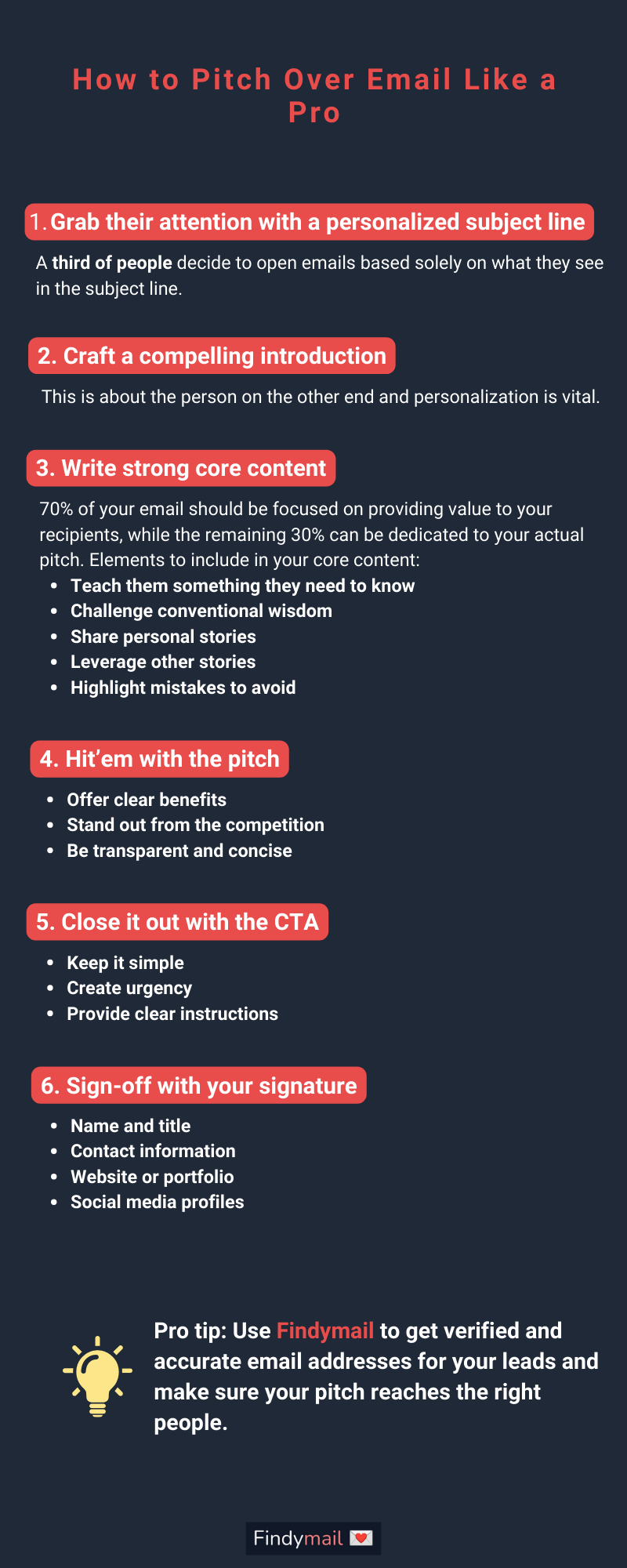Email is a marketing and communication channel you simply can't afford to ignore. I mean, email users are projected to reach a staggering 4.6 billion by 2025, and email marketing boasts an impressive ROI of $40 for every $1 spent.
So in this article, I'm going to share tips and tricks for becoming a pro at pitching over email.
I'll walk you through a step-by-step guide that will help you harness the power of a well-crafted email pitch, complete with practical examples and handy templates to jumpstart your success.
So let’s hop right into it!
Step-by-Step Guide to Crafting an Email Sales Pitch
Step 1: Grab Their Attention with a Killer Subject Line
The subject line is undeniably one of the most crucial elements of your email.
It's the first thing recipients see, and it can determine whether your email gets opened and read or swiftly sent to the dreaded trash bin.
In fact, did you know that a third of people decide to open emails based solely on what they see in the subject line? That's how important it is!

Now, here's the key: your subject line should never be spammy or deceptive with phrases like "100% Guaranteed!" or anything that might trigger spam filters.
Instead, the real power lies in personalization. And keep it simple, sweet, and direct.
(Source)
A subject line that resonates with the recipient's interests and needs is more likely to pique their curiosity and encourage them to open your email.
Here are a few examples to get your creative juices flowing:
- Hey [Name], Quick Question for You
- [Product/Service]: Your Solution to [Specific Pain Point]
- Exclusive Offer Inside: [Benefit] Just for You, [Name]!
- You're Invited: Join [Company/Event] and [Benefit]
- "Name], I Have an Idea That Could [Achieve Desired Outcome]
Remember, personalization is key. Tailor your subject line to the individual recipient, highlighting the value and benefits they can expect from your email.
Step 2: Craft a Compelling Introduction
Your introduction or opening is the initial connection that determines whether your recipients will eagerly read on or simply hit that dreaded "delete" button.
When crafting your introduction, remember that it's not about you – it's all about the person on the other end.
First of all, you want to address them by name. It’s a small gesture that adds a personal touch to your email and shows that you acknowledge them as an individual, not just another faceless contact.
And again, personalization is a vital part of your entire approach.
Whether you reference a recent post they made on social media or find a shared interest, like being a Game of Thrones fan, finding that connection can break the ice and create an immediate rapport.
Take a look at this email from DeFiChronicles.
You see how they jumped in by putting the focus on the reader? And then they round it out with a little bit of flattery before diving into the pitch.
That’s what the introduction is all about – establishing rapport. There’s no need to overdo it and make it too long. It’s like the small talk you have sitting at the negotiation table.
Step 3: Write a Strong Core Content
Now we’re at the heart of your email – the core content.
There’s one key point I want you to take from this step: the 70/30 rule.
70% of your email should be focused on providing value to your recipients, while the remaining 30% can be dedicated to your actual pitch.
(Source)
Here are some elements you can include in the core of your email:
- Teach them something they need to know: Share valuable tips, tricks, or how-to instructions related to a topic your recipients are interested in. Empower them with the knowledge that can help them overcome challenges or achieve their goals.
- Challenge conventional wisdom: Discuss why other experts might be wrong or present a different perspective on a commonly held belief. Engage your readers by offering an alternative viewpoint that sparks their curiosity.
- Share personal stories: Narrate your own journey or the success story of one of your clients. Personal anecdotes create an emotional connection and showcase the real-life impact of your product or service.
- Leverage other stories: Incorporate stories of relevant individuals who have achieved success or made mistakes. These stories serve as powerful examples and provide valuable insights.
- Highlight mistakes to avoid: Educate your recipients on common pitfalls or errors they might be making. By showcasing what not to do, you position yourself as a knowledgeable guide and reinforce the value of your solution.
Remember, the core of your email is your opportunity to deliver value and establish credibility. Keep your writing engaging, concise, and relevant to your recipients' needs.
Step 4: Hit’em With the Pitch
By now, you've addressed your recipients' pain points and showcased your unique value proposition. It's time to make your offer and demonstrate why they should choose to work with you over any competitor out there.
Keep the following in mind when you’re working on your pitch:
- Offer clear benefits: Clearly articulate how your product or service will benefit your recipients. Highlight the specific solutions or advantages they can expect by choosing to work with you. Make it evident why your offering is superior and how it directly addresses their needs.
- Stand out from the competition: Differentiate yourself from competitors by emphasizing what sets you apart. Showcase your unique selling points, whether it's your expertise, innovative approach, exceptional customer service, or a combination of factors. Help your recipients understand why you're the best choice for their needs.
- Be transparent and concise: Ensure your pitch is clear and easy to understand. Avoid using jargon or overly complex language that might confuse your recipients. Get straight to the point and clearly state what your product or service is, or if you're requesting a guest post or introduction, outline what you're looking for and the potential benefits for them.
(Source)
Remember, your pitch is the culmination of your email, the moment where you present a compelling offer that seals the deal.
Step 5: Close It Out with the CTA
Congratulations, you've made it to the end of the pitch!
Now, it's time to guide your recipients toward the desired next step by incorporating a strong call-to-action (CTA). The CTA is a crucial element that prompts your readers to take action and engage with your offer.
When creating your CTA, keep the following tips in mind:
- Keep it simple: A CTA should be straightforward and easy to understand. Avoid overwhelming your recipients with multiple calls to action in a single email. Instead, focus on one clear and specific action you want them to take. Whether it's replying to the email, visiting your website, scheduling an appointment, or downloading a resource, make it clear and concise.
- Create urgency: To motivate prompt action, add a little sense of urgency to your CTA. You can emphasize limited-time offers, exclusive discounts, or a deadline for taking advantage of your offer. By creating a sense of urgency, you encourage your recipients to act swiftly rather than putting it off for later.
- Provide clear instructions: They need to know exactly what to do to fulfill the CTA. Give them clear guidance on how they can take the desired action. Include any necessary links, contact information, or steps they need to follow. Make it as easy as possible for them to respond or engage with your offer.
By including a strong CTA, the recipient knows exactly what you want them to do and how to do it.
Step 6: Sign-Off with Your Signature
Your email signature serves as a virtual business card, providing recipients with your contact information and giving them an opportunity to learn more about you before deciding to do business with you.
Here are the core elements of a good signature:
- Name and title: Of course, you need your full name and professional title.
- Contact information: Include your phone number, email address, and any other relevant contact details. Make it easy for recipients to reach out to you through their preferred method.
- Website or portfolio: If applicable, include a link to your website or portfolio. This allows recipients to explore more about your products, services, or expertise.
- Social media profiles: If you have professional social media profiles, such as LinkedIn or Twitter, you can include relevant links. This allows recipients to further connect with you and learn more about your professional background.
And boom, now you’ve got a fancy signature to sign off your emails.
Pro-Tip: Use Tools Like Findymail to Level Up Your Pitch Game
Technology is your best friend when it comes to streamlining your sales pitch efforts.
For example, Findymail takes the guessing game of email addresses. It helps you find legit and valid email addresses, so you can be confident your pitches reach the right inbox.
And you can use tools like Sales Nav to build your prospect list and research. Then you can combine it all with Apollo.io so you can set up personalized email sequences, follow-ups, and reminders, and automate your email campaigns.
Really, don’t sleep on tech when it comes to leveling up your sales game.
7 Sales Pitch Email Examples and Templates
OK, let’s take a peek at some templates and examples you can use for inspiration to make your own winning sales pitch email.
Example 1
(Source)
Example 2
(Source)
Example 3
(Source)
Example 4
(Source)
Example 5
Template 1
Hello [First name],
I wanted to reach out and share some exciting news with you. Our team at [Company] has been working tirelessly to create an incredible offer that I think you'll find truly valuable.
Introducing our latest initiative: [product/service]. We've put together an exclusive group offer that has been generating quite a buzz. Even though we've already welcomed over 1,000 new members, there's still plenty of space for you to join. Plus, by participating, you'll not only benefit from fantastic discounts but also contribute to supporting our local community.
I would like to extend early VIP access to [the content]. We're gearing up for a special launch event on [date], and I want to ensure you have the opportunity to be part of it. To learn more about this exciting offer, I've attached an exclusive copy for your reference.
Feel free to reach out to me directly with any questions or if you're ready to seize this opportunity.
Warm regards,
[Your Name]
[Your Job Title]
[Contact Information]
Template 2
Hey [First name],
I came across your recent post on [subject/platform], and I have to say, I loved it! Your insights were truly inspiring, and it motivated me to take action.
I actually went ahead and purchased some of your [product], and I must say, they exceeded my expectations. They are absolutely fantastic! Your attention to detail and quality really shine through.
While browsing through your profile, I noticed that we share an interest in similar products. This got me thinking, have you ever explored [your company]? We have a remarkable line of [products] that I believe would be a perfect fit for your company.
If you're open to it, I'd love to send you a free sample to try out. We stand by our products and are confident that you'll be impressed by their performance. Feel free to check out our customer reviews and the success stories we've had on our website [insert website link].
Please let me know if you're interested in learning more or receiving that free sample. I'm here to answer any questions you may have.
Best regards,
[Your Name]
[Your Job Title]
[Contact Information]
Sales Pitch Email Best Practices
Here are 6 best practices for getting the most out of your sales pitch emails.
1) Personalization is a Must
I can’t stress this enough, but personalization is absolutely crucial.
I mean, who wants to receive a cookie-cutter, generic message that feels like it was sent to a thousand other people, right?
Take the time to dig deep and understand your recipients – their needs, preferences, and pain points. Address them by name, show that you've done your homework, and make it clear that you genuinely care about their individual situation.
Trust me, a little personal touch goes a long way in grabbing their attention and getting that response you're after.
2) Make Sure You Follow-Up
Hey, we're all busy bees, and sometimes emails can get lost in the abyss of our inboxes. So, don't give up after just one attempt!
It's time to channel your inner persistence and send a friendly follow-up email. Be polite, remind them of your offer, and show that you're genuinely interested in connecting.
Timing is key here, so give them a reasonable window before reaching out again. Remember, the fortune is in the follow-up.
3) Understand and Prepare for Objections
Objections are little roadblocks on your path to success. But if you can anticipate them, it can be your secret weapon.
Put yourself in their shoes and think about what might be holding them back. Then, arm yourself with compelling answers or solutions to address those concerns head-on.
By showing that you've thought it through and have their best interests at heart, you build trust and credibility. Knock down those objections like a pro, and watch those deals roll in.
4) Don't Be Afraid to Get Creative
It's a noisy world out there, and your email pitch needs to cut through the inbox clutter. Embrace your creative side and think outside the box.
Add some spice to your emails with visuals like images or even short videos. A picture is worth a thousand words, they say, and a well-placed emoji can bring some personality and differentiate you from the competition.
So, go ahead and let your creativity shine. Just remember to keep it professional and aligned with your brand.
5) Keep the Customer at the Center of Your Approach
It's not about you – it's all about them. Take a customer-centric mindset when crafting your emails. Understand their wants, needs, and desires.
Speak their language, address their pain points, and offer solutions that genuinely help them.
Believe me, when you make it crystal clear that you're focused on their success, you'll win their hearts and their business.
6) Keep it Short and Sweet
Look, nobody has the time or patience to read through a novel-length email.
Get your message across without beating around the bush. Respect their time and make every word count. You want to capture their attention and convey your value proposition quickly.
Remember, brevity is the name of the game. So, trim the fluff, keep it snappy, and watch your response rates soar!
Knock It Out of the Park & Pitch Like a Pro!
That’s all, folks – everything you need to know about pitching like a pro through email. With this comprehensive guide, you now have a step-by-step roadmap to crafting compelling sales pitch emails that grab attention, engage your recipients, and drive results.
And remember, you’ve got Findymail on your side. Pitch with confidence and trust your deliverability won’t suffer.
Now get out there and slay with your pitches!




